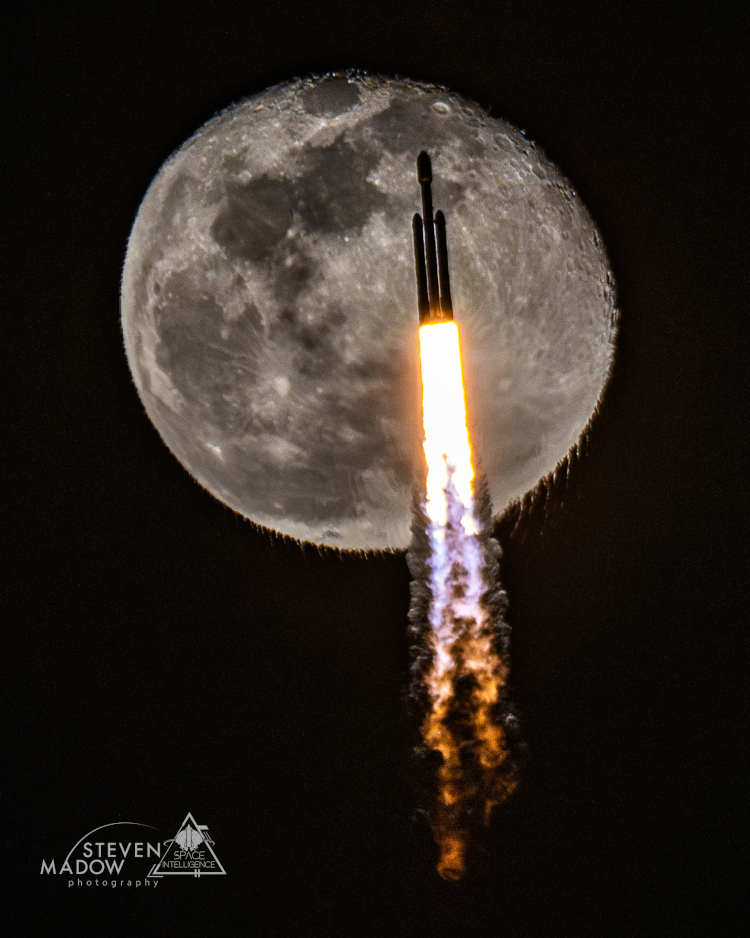The latest ‘Too Cool’ entry comes from Astronomy Picture of the Day again, but wonder of wonders, it’s not a composite edited photo – I was starting to think this was a requirement for them. Instead, this is a carefully planned and timed shot, one that took a lot more effort than it might first appear.

Full credit to Steven Madow for this one, because it’s pretty damn slick, and let’s look into this a little deeper. First off, getting anything crossing in front of the moon is trickier than it seems, because it’s really a tiny patch of sky, about the apparent size of you fingertip, and it’s very easy to pass on either side. But having a launched space vehicle do so?
First, the moon can only be so high in the sky, so within a few hours of rising or setting – in this case rising, because the launch was from Cape Canaveral so you’d have to be out to sea to silhouette something launched from there against a setting moon. But the moon crosses the sky in a fixed arc and at a fixed speed, moving its own width in roughly 150 seconds (it varies a little because the moon varies distance from Earth and thus apparent width.) Neither the launch facility nor the moon can be adjusted in any way, so only the photographer’s position can be changed – essentially, if the launch is delayed, the photographer has to move north to keep the launch path aligned with the moon, since that’s moving south as it rises. There’s always a certain distance that the public has to be from the launch pad, so this means quite a bit of movement for every minute that launch slips. I’m guessing that this one was right on time, otherwise setting up the tripod would become impossible within minutes.
There’s also the launch path to consider. Sure, it’s easy to know where it will begin from, but it doesn’t take too long before the path starts to arc over to put the rocket into orbital position – again, this doesn’t have to be very far to miss entirely. You’ll notice that the rocket is not straight vertical, meaning that it had already started that transition.
Then there’s speed. Space vehicles accelerate rapidly, so not too long after launch it’ll be fast enough to cross the moon in far less than a second; not only does the timing have to be bang-on, but the shutter speed fast enough to freeze it and still get a decent exposure of the moon. Go the the original link and click on the photo to view the full-resolution version, and you’ll see the speckly artifacts and grain of using a high ISO setting. You will also see a glow on the bottom of the payload housing in the nose, illuminated by its own exhaust.
Finally – and I don’t know if this was planned or not – there’s catching the Falcon Heavy with the boosters more-or-less flat to the camera; I mean, you can see the gap between them and the main body. It wouldn’t take much rotation of the rocket to make this totally different and less dramatic.
So now I did a little plotting, because I do things like this. The launch of the Falcon Heavy was at 20:07 EST on December 28th from pad LC-39A. At that point, the moon was roughly 18° in the sky, azimuth 68° (East-Northeast.) That would put photographer Steven Madow about 248° from pad LC-39A, and there’s no location even close to that on the Cape where he’d likely be shooting from, even if he had permission from NASA to be there. This means he was probably on the mainland of Florida, Titusville area, and I’m guessing somewhere along Riveredge Drive just north of NASA Causeway – this would have given him the best unobstructed views and plenty of room to play with should the launch time slip. Which would also mean better than 20 kilometers from the pad itself, increasing steadily as the rocket climbed. Moreover, the moon was moving more ‘up’ than ‘south’ at that time, minimal change in azimuth, so not quite as hard to readjust if the launch time shifted.
All that said, just a smokin’ great photo from Steven Madow, and it’s not the first time that he’s done it either – but possibly the best so far.




















































